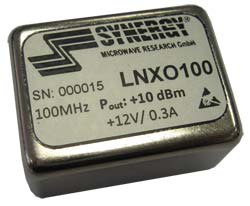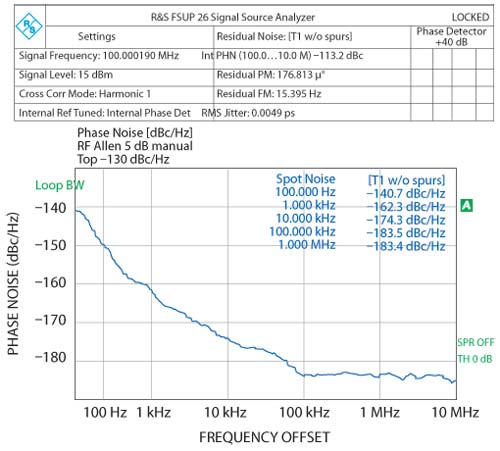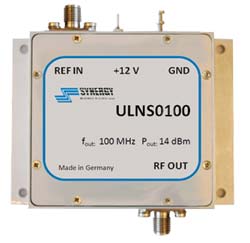
Over recent years the phase noise behavior of crystal based oscillators has been steadily improved, driven by new modulation-types up to 4096 QAM that require extremely low jitter sources. Also, ultra-low-noise sources improve the performance of radar systems and are particularly suited to instrumentation applications in bit-error-rate testers and in laboratory references.
Often companies select crystals that offer the best phase noise performance. However, such crystals can be expensive and unpredictable, and therefore unsuitable for mass-production. The ability to understand the quartz and oscillator behavior, combined with patented noise cancelling feedback technologies, allied to a quartz-supplier who has the capability to deliver constant performance, facilitates the design of small VCXOs with unique specifications and a good price-performance-ratio.
Synergy Microwave Research GmbH is able to meet these criteria with its LNXO-series that is available with some standard frequencies, packages and options with good phase noise performance, yet without the need for quartz-selection. As well as standard LNXOs, customized frequencies and other specifications such as increased output power are available on request.

Figure 1 Example of a phase noise ratio test report.
Performance as standard
A standard product is the LNXO100, which gives a 100 MHz signal with typically +10 dBm output power. Its phase noise performance is -135 dBc/Hz at 100 Hz (-140 typical), minimum -160 dBc/Hz at 1 KHz (-162 typical) and the noise floor is typically -183 dBc over the temperature range of -20°to +60°C. In reality, the performance is better than the typical data and on request the company will make a selection and guarantee the better performance, as illustrated in the phase noise test report shown in Figure 1. Harmonics below -35 dB guarantee a clean spectrum.
The frequency stability over temperature is <±0.2 ppm and the VCXO ages at ±0.3 ppm/year after 30 days of continuous operation. Frequencies can be electrically adjusted at ±5 ppm with an external tuning voltage of 1 to 10 V. Also, the guaranteed jitter specification of 10 fs (typically 6 fs) gives the best performance for fast A/D-converter clocks.

Fig. 2 The ULNS0100 is a connectorized version of the LNXO100.
SHOCK AND VIBRATION
Because of the use of shock-resistant and vibration optimized quartz-holders and SC-cut crystals, the VCXOs are particularly suitable for military systems where excellent shock and vibration resistance are prerequisites. The LNXO100 is available in a standard 5-pin OCXO and in a connectorized package (Figure 2 shows the ULNS0100, which is a connectorized version of the LNXO100), with an SMD-package soon to be available.
Another example is the LNXO125 that delivers a 125 MHz-signal with a minimum phase noise performance of -135 dBc/Hz at 100 Hz (-140 typically), minimum -160 dBc/Hz at 1 KHz (-162 typical) and a noise floor of typically -183 dBc over a temperature range of -20°to +60°C.
All packages offer a GPS-receiver option that synchronizes the LNXO-signal to a GPS signal, which gives the oscillator good long-term-stability combined with good phase noise performance. In addition, a built-in-option for external locking to a long-term, stable signal, as a rubidium standard, will be available soon.
Future developments
Currently 100 and 125 MHz VCXO versions are available and other frequencies are under development, while additional frequencies can be developed upon request from customers.
Synergy Microwave Corp.
(Research GmbH),
Paterson, NJ
(913) 881-8800,
info@synergymwave.com,
www.synergymwave.com
